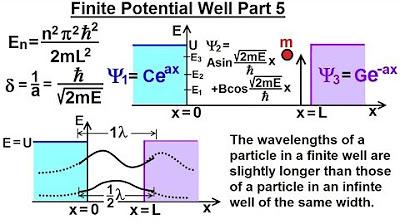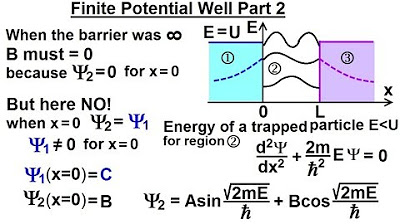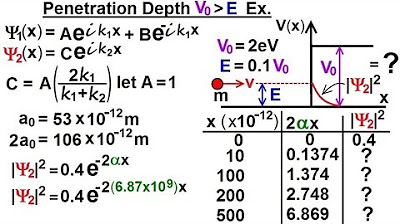Physics - Ch 66 Ch 4 Quantum Mechanics: Schrodinger Eqn (32 of 92) Finite Potential Well Part 1
TLDRThis video delves into the concept of a particle in a finite well, contrasting it with an infinite well scenario in quantum mechanics. It explains that in a finite well, the barriers have less than infinite energy, allowing particles to exist partially in regions outside the well. The video uses Schrödinger's equation to explore the mathematical solutions for regions inside and outside the well, highlighting how the energy of the particle and the barrier's height influence the particle's distribution. It concludes by introducing the idea of quantum tunneling, where particles can partially exist in 'forbidden' regions if they possess sufficient energy.
Takeaways
- 🌟 In a finite well, the barriers have finite energy, allowing a particle to exist partially in regions outside the well.
- 🚧 The energy of a trapped particle is less than the energy required to overcome the barrier, but it can still penetrate into the barrier to some extent.
- 📝 Schrodinger's equation is used to describe the particle's behavior, and when modified for finite wells, it simplifies to a standard form.
- 🔄 The general solution for regions 1 and 3 involves exponential functions, but certain parts must be discarded for physical reasonableness.
- ∞ When x approaches negative or positive infinity, certain exponential terms would also approach infinity, which is not physically valid.
- 🔄 The coefficients C and F in the general solution are determined by the energy of the particle and the barrier's properties.
- 📉 For a particle with energy close to the barrier, the decay in region 3 is slow, indicating a gradual decrease in the wavefunction.
- 🚶 The particle can potentially 'tunnel' through the barrier if it has enough energy, a phenomenon unique to quantum mechanics.
- 📈 The greater the energy of the particle, the more it can penetrate into the 'forbidden' region beyond the barrier.
- 🧠 Understanding the finite potential well is crucial for grasping quantum mechanical behavior, and further videos will explore this concept in more depth.
Q & A
What is the main difference between a particle in a finite well and an infinite well?
-In a finite well, the barriers have finite energy, allowing a particle to venture outside the trap region, whereas in an infinite well, the barriers have infinite energy, preventing the particle from leaving the trap region.
What does it mean for a particle to have energy less than U?
-It means that the particle's energy is less than the energy required to overcome the barrier, but it can still get through the barrier or at least into the barrier to some extent.
How does Schrödinger's equation help in understanding a particle in a finite well?
-Schrödinger's equation provides a mathematical framework to describe the quantum state of the particle. By solving it, we can find the wavefunction, which gives us information about the probability distribution of the particle in different regions.
What happens when we solve the Schrödinger's equation for a finite well?
-We get a differential equation with standard solutions that describe the particle's wavefunction in regions 1 and 3, which are outside the well region. These solutions help us understand how the particle's probability distribution changes in these regions.
Why do we exclude the term e^(-ax) when considering region 1?
-We exclude e^(-ax) in region 1 because as x approaches negative infinity, this term would lead to an infinite solution, which is not physically meaningful for a particle in a finite potential well.
What is the significance of the parameter 'a' in the context of a finite well?
-The parameter 'a' is related to the energy difference between the particle's energy and the barrier height. It determines the decay rate of the wavefunction in regions 1 and 3, affecting how the particle's presence diminishes as it moves away from the well.
How does the energy of the particle (E) affect the parameter 'a'?
-As the energy of the particle (E) approaches the barrier height (U), the value of 'a' becomes smaller, leading to a slower decay of the wavefunction in region 3, meaning the particle has a higher probability of being found further from the well.
What does the wavefunction in a finite well look like in regions 1 and 3?
-In region 1, the wavefunction looks like an exponentially decaying function as you move away from the well, while in region 3, it also decays exponentially but in the opposite direction, indicating the particle's presence diminishes as it moves away from the well on the other side.
What is quantum tunneling, and how does it relate to a particle in a finite well?
-Quantum tunneling is a phenomenon where a particle can pass through a barrier that it classically shouldn't be able to overcome. In the context of a finite well, as the particle's energy gets closer to the barrier height, there is a non-zero probability of the particle tunneling into the classically forbidden region.
How does the mass of the particle and the energy difference influence the parameter 'a'?
-The parameter 'a' is primarily determined by the mass of the particle and the difference in energy between the particle's energy in the well region and the energy required to overcome the barrier. A heavier particle or a smaller energy difference results in a smaller 'a', leading to a slower decay of the wavefunction.
Outlines
🌟 Understanding Particles in Finite and Infinite Wells
This paragraph introduces the concept of a particle in a finite well versus an infinite well. It explains that in a finite well, the barriers do not have infinite energy, allowing a particle to venture outside the trap region. The energy required to escape the well is finite, which means the particle can exist partially in the barrier regions. The discussion focuses on the energy of the trapped particle being less than the energy required to overcome the barrier and how this energy dynamic affects the particle's behavior in different regions. The paragraph also delves into the mathematical representation of this scenario using Schrödinger's equation, highlighting the standard solutions for regions outside the well and how the values of constants C and a, determined by the particle's energy and mass, influence the particle's distribution.
🚧 Quantum Tunneling and the Finite Potential Well
The second paragraph continues the exploration of the finite potential well, discussing the phenomenon of quantum tunneling. It explains that as a particle's energy approaches the energy required to overcome the barrier, it can partially exist in regions 2 and 3, which are initially considered inaccessible. The greater the energy, the closer the particle gets to the barrier's energy threshold, allowing it to 'tunnel' into the forbidden region. This section emphasizes the unique properties of quantum mechanics that enable particles to be in multiple states simultaneously and provides an introduction to the potential well, setting the stage for further exploration in subsequent videos.
Mindmap
Keywords
💡Particle
💡Finite Well
💡Quantum Mechanics
💡Barrier
💡Energy
💡Schrödinger's Equation
💡Wavefunction
💡Tunneling
💡Potential Energy
💡Differential Equation
💡Decaying Function
Highlights
The concept of a particle in a finite well is introduced, contrasting with an infinite well.
In a finite well, the barriers have finite energy, allowing a particle to venture outside the trap region.
The energy required to get out of the trapped region is finite and quantified as you are you.
The trapped particle's energy is less than the energy required to overcome the barrier.
The particle can get through or into the barrier to some extent, unlike in an infinite well scenario.
The exploration of regions 1 and 3 for the particle's behavior is discussed.
Shirley's equation is used to describe the particle's behavior, with modifications for finite energy barriers.
The differential equation and its standard solutions are identified for regions 1 and 3.
The general solution for regions 1 and 3 involves exponential functions with constants C and F.
The solution for region 1 is modified to exclude the term that would lead to an infinite value as X approaches negative infinity.
Similarly, the solution for region 3 excludes the term that would lead to an infinite value as X approaches positive infinity.
The value of a in region 1 is determined by the energy of the particle and the barrier's energy.
As the particle's energy approaches the barrier's energy, the value of a becomes smaller, allowing the particle to potentially go farther into region 1.
In region 3, a small value of a suggests a slow decaying function for the particle's wavefunction.
The wavefunction of a particle in a finite well exhibits different characteristics in regions 1 and 3.
Quantum mechanics allows for the possibility of a particle tunneling through the barrier and existing in the forbidden region.
The introduction provides a foundation for further exploration of the finite potential well in quantum mechanics.
Transcripts
Browse More Related Video

Physics - Ch 66 Ch 4 Quantum Mechanics: Schrodinger Eqn (36 of 92) Finite Potential Well Part 5

Physics - Ch 66 Ch 4 Quantum Mechanics: Schrodinger Eqn (33 of 92) Finite Potential Well Part 2

23. Quantum Mechanics V: Particle in a Box

Lecture 11: Dispersion of the Gaussian and the Finite Well

Physics - Ch 66 Ch 4 Quantum Mechanics: Schrodinger Eqn (77 of 92) The Barrier: An Overview

Physics - Ch 66 Ch 4 Quantum Mechanics: Schrodinger Eqn (76 of 92) Penetration Depth V0, E: Ex.
5.0 / 5 (0 votes)
Thanks for rating: